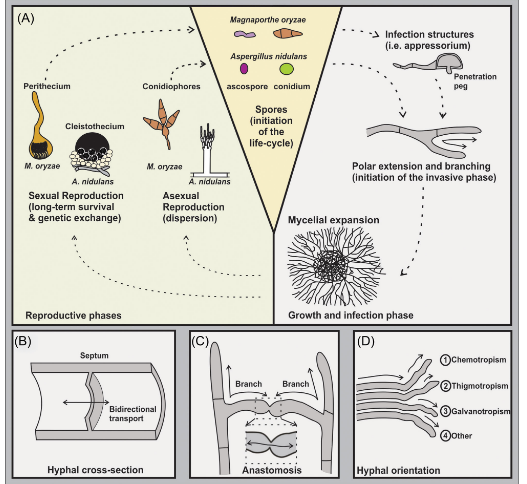Hyphae & similarities with neurons
.jpg)
Fungiː Hyphae. Lactophenol cotton blue dye.
Several fungal species penetrate substrates and accomplish host invasion through the fast, permanent, and unidirectional extension of filamentous cells known as hyphae. However, polar growth results in a significant increase in the distance between the polarity site, which receives the newest information about ambient conditions, and the nuclei, where adaptive responses are executed.
Recent studies show that these long distances are overcome by signal transduction pathways that convey sensory information from the polarity site to the nucleus. The mechanisms for long-distance communication in hyphae share spectacular similarities with those from neurons.
Transmission of information via hyphae
One of the vital functions of fungi is their ability to interact with their environment and adjust to changes. An efficient adaptation, however, requires an accurate transduction of external information. This process is hard to do because polarity sites and nuclei in neurons and hyphae are far apart. The polarized exocytosis processes reviewed above result in signalling proteins reaching polarity sites, enabling the retrograde flow of information.

The above shows the development of spores to hyphae.

Neurons—Mechanism for growth cone extension and axon guidance. (A) Molecular organization within the growth cone and its turning in response to guidance cues. P- (gray), T- (purple) and C- (blue) regions are indicated, together with MTs, actin filaments, arcs and bundles, molecular motors and exocytic/endocytic vesicles. The growth cone extends toward attractive cues, avoiding repulsive signals. Modified from Lowery and Van Vactor (2009). (B) Binding of filopodia and lamellipodia to the extracellular matrix. (C) Advance of filopodia and widening of the T-zone (due to actin polymerization). (D) Advance of the C-domain due to the invasion of the T-zone by MTs from the C-region. (E) MTs at the growth cone neck are compacted, stabilizing a new segment of the axon shaft
To be continued …
Copyright © 2022 Geoffrey David Cowne
